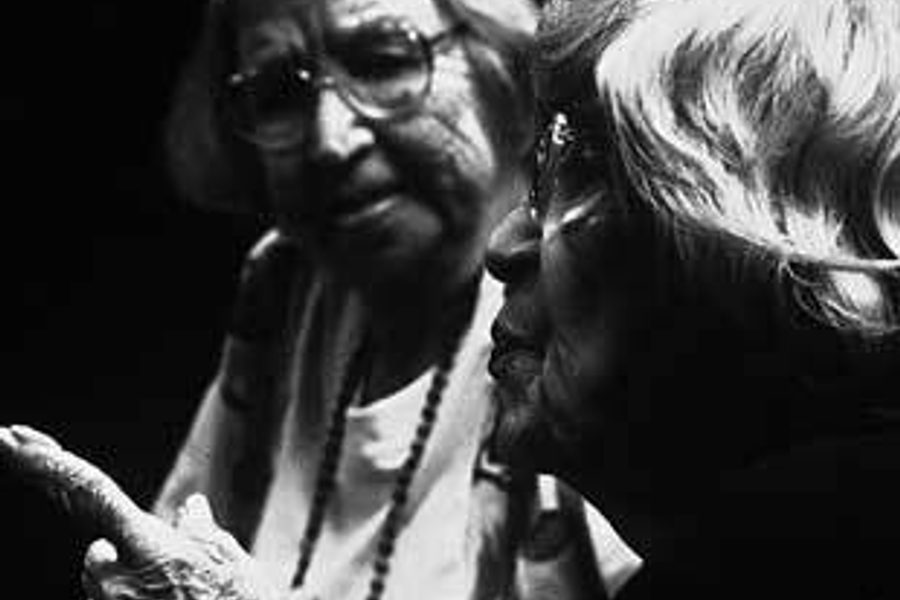
It’s not the usual retirement home that has residents who want — or are allowed — to attach hand-scrawled “Free Mumia” placards outside their doors, but that’s typical at Sunset Hall.
The motto “A Home for Free-Thinking Elders is emblazoned on the side of the hall’s bus, which might be taking them to a demonstration against the transit authority in Los Angeles or to a peace rally, instead of just down to the doctor’s office. In addition to the usual food complaints (“We didn’t get a single fresh peach this summer”), snatches of mealtime conversation include passing references to politics — “It wasn’t a revolution, people just stormed the parliament,” a resident is overheard explaining.
Sunset Story, the documentary that explores this unique institution, stays close and intimate with two residents of Sunset Hall: Irja Lloyd, a retired teacher, and Lucille Alpert, a former social worker. Arriving at Sunset Hall within two weeks of each other, they struck up a supportive friendship that both consider lifesaving. Their personalities, sturdy and often comic, carry the film. Lloyd is earnest and tireless in her wheelchair, checking on all the employees to make sure they register to vote. She is determined to create a Jewish New Year celebration for her friend Alpert, who goes along somewhat grudgingly because she says she was raised to assimilate. Alpert points out that she has never even heard of the customs Lloyd assiduously digs up and enacts. For her part, Alpert has a keen and understated wit. As the two coordinate plans for a walker lap around the hall’s refreshing inner courtyard, she says as dryly as any British comic, “I’m so excited.”
The two make an engaging pair, but they won’t change your ideas about aging and the aged, as the film’s publicity suggests, unless, say, you have lived all your years in Paris Hilton-style oblivion to real life. The documentary does not lapse into “aren’t-they-cute” condescension, but it does seem overcome by that other pervasive cliché about growing older — that the older you are, the more your life is about dying.
The film’s march toward death became unavoidable once filmmaker Laura Gabbert chose to hone in on two individual personalities, one of whom receives a diagnosis of terminal cancer. This is handled with tasteful restraint, except for some lapses with music to underline how sad it all is.
On the filmmakers’ Web site (www.sunsetstory.org), Gabbert says she set out to make a portrait of Sunset Hall, but instead decided to hone in on the story of the friendship between Alpert and Lloyd. She wanted the film to have “the feeling of a character-driven narrative film.” Screens big and small are overrun with narrative films, both nonfiction and fiction, and most of them are character-driven, if not always with characters as interesting as these two. Our commodity-and-entertainment-driven society often tries to bury history prematurely; the free-thinking seniors at Sunset Hall, trained in activism, would surely insist on the importance of placing a narrative within its political and social context.
To be generous to the filmmakers, Sunset Story seems a little squeezed into its 53-minute PBS time slot, cut down from the 73 minutes at which it played festivals and won awards. I hope that’s the explanation for what’s missing: more about how Alpert and Lloyd live in Sunset Hall, as well as the 82-year-history of the Hall, which includes what the LA Weekly termed a “residents’ coup” in 1989 to prevent sale of the building to a developer, and another disagreement with the Board of Directors during a financial crisis in 2003.
And what kind of neighbor is Sunset Hall among the Koreans and Latinos with whom it shares its mid-Wilshire location in Los Angeles? What are the hall’s employment policies in an infamously pinchpenny and corner-cutting sector of the health industry? Somewhere between undistracted narrative and dry recitation of statistics, there must be a way to tell the full story of individuals, including the politics of the surroundings in which they live to their dying day.
Someday I’ll be a “free-thinking elder” (I hope), and these are things I want to know about now, in addition to seeing a touching vignette of friendship and continuing activism.

I hope you found this article important. Before you leave, I want to ask you to consider supporting our work with a donation. In These Times needs readers like you to help sustain our mission. We don’t depend on—or want—corporate advertising or deep-pocketed billionaires to fund our journalism. We’re supported by you, the reader, so we can focus on covering the issues that matter most to the progressive movement without fear or compromise.
Our work isn’t hidden behind a paywall because of people like you who support our journalism. We want to keep it that way. If you value the work we do and the movements we cover, please consider donating to In These Times.





